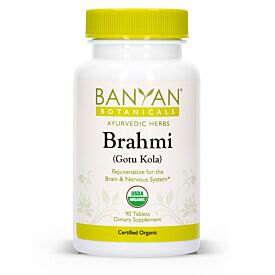Ayurvedic Herbs: Brahmi
/Ayurvedic Herbs
Ayurvedic herbs are one of the many chikitsas or treatments used in Ayurvedic medicine. These herbs are used as part of an herbal protocol recommended by an Ayurvedic professional. Thusly, all the Ayurvedic herbs should not be self-administered and Ayurvedic herbs should only be taken under-advisement of your Ayurvedic Counselor/Practitioner/Doctor and approved by your Primary Care Physician. The information on the Ayurvedic herb of Brahmi is only meant to educate you on the ways in which it is traditionally used in Ayurveda and is presented for educational purposes only. It is not intended as a substitute for the diagnosis, treatment, or advice of a qualified, licensed medical professional. The facts presented are offered as information only, not medical advice, and in no way should anyone infer that we are practicing medicine. Seek the advice of a medical professional for proper application of this material to any specific situation. Do not use the information found within this post to self-diagnose any medical conditions or treat any health problems or diseases. The information provided is not intended to prescribe or be taken as medical advice. If you have or suspect that you have a medical condition please contact your health care provider immediately.
“The essence of all beings is Earth. The essence of Earth is Water. The essence of Water is plants. The essence of plants is the human being.
Esam bhutanam prthivi rasha, prthivya apo raso-pam osadhayo rasa, osadhinam puruso rasah.”
Brahmi
Latin Name: Bacopa monniera-Folium
Plant Family: Scrophulariaceae
English Name: Bacopa
Sanskrit Name: Brahmi is the energy (or shakti) of Brahman meaning universal consciousness
Part Used: root, plant
Botanical Description: leaves have small spots; flowers are lavender or pink; 5-7 leaves in a bunch and are soft and thick
Taste (Rasa): bitter, sweet
Energetics (Virya): cooling
Post-Digestive Effect (Vipaka): sweet
Quality (Guna): light, flowing
Dosha: VPK=, V+ in excess
Tissues (Dhatu): mainly plasma (rasa), mainly blood (rakta), muscle (mamsa), fat/adipose tissue (meda), bone (asthi), mainly nerve/bone marrow (majja), reproductive tissue (shukra [male]/artava [female])
Systems (Srotamsi): circulatory (rakta vaha srotas), digestive (anna vaha srotas), nervous (majja vaha srotas), excretory (purisha vaha srotas), muscular (mamsa vaha srotas)
Constituents: saponins (steroidal bacoside A & B); alkaloids (brahmine, herpestine); flavonoids
Actions: brain tonic, sedative, antispasmodic, alterative, diuretic, astringent
Ayurvedic Actions: calms vata (vatahara); redirects the flow of vata downwards (anuloma); reduces mental upset (unmadahara), increases intellect (prajnasaktivardhana); heart tonic (hridaya); rejuvenative, particularly to nervous system (majjadhatu rasayana); increases longevity (ayusya vardhana); gives strength (balya); promotes energy (jivaniya); nervine (medhya); promotes sleep (nidrajanana); alleviates skin conditions (kusthaghna)
Biomedical Actions: sedative, nervine, cardiotonic, antispasmodic, anticonvulsant, anti-inflammatory
Indications: brain, nerves, urinary, external, mind, skin
Precautions: may aggravate itching; in large doses may cause headaches or temporary loss of consciousness, caution during pregnancy; caution is advised with anti-epileptic and antidepressant medication
Preparations: powder, decoctions, juice
Formulations: brahmiprash, saraswatarishta, brahmighruta, brahmitalia
Brahmi has a special affinity for the nervous system and the mind. It is especially beneficial for Vata prakruti (constitution) and vikruti (imbalances). Brahmi is oftentimes associated with Gotu Kola, but they are different herbs with different Ayurvedic properties.
References
Frawley D. Yoga & Ayurveda: Self-Healing and Self-Realization. Twin Lakes, Wisconsin: Lotus Press; 1999.
Frawley D, Lad V. The Yoga of Herbs: An Ayurvedic Guide to Herbal Medicine. Twin Lakes, Wisconsin: Lotus Press; 2001.
Gogte VM. Ayurvedic Pharmacology & Therapeutic Uses of Medicinal Plants: Dravyagunavignyam. New Delhi, India: Chaukhambha Publications; 2016.
Pole S. Ayurvedic Medicine: The Principles of Traditional Practice. Philadelphia, PA: Singing Dragon; 2013.








